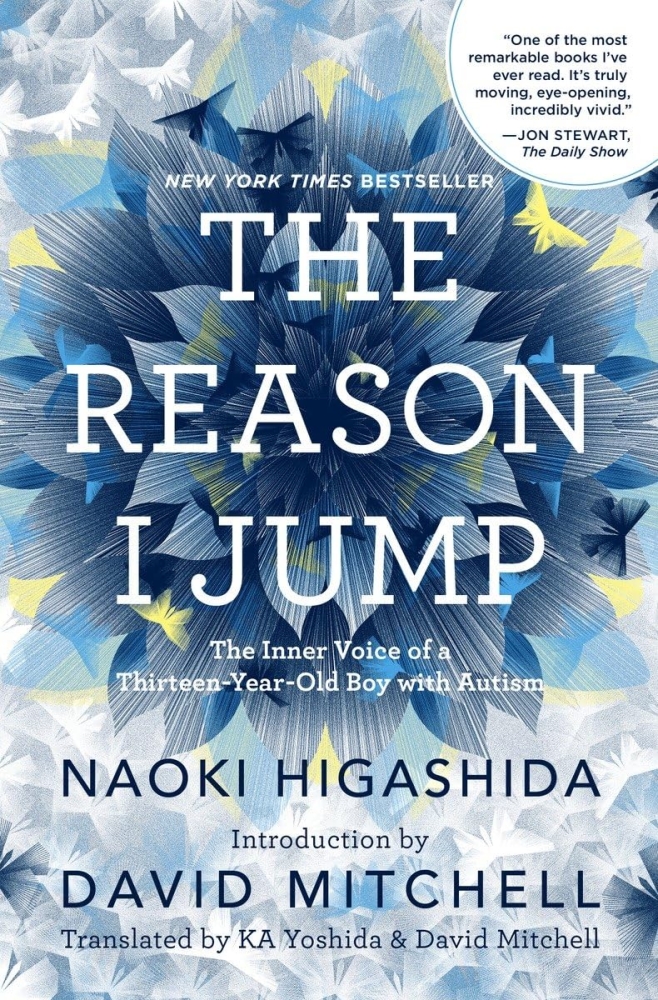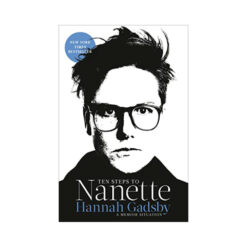When Naoki Higashida was 13 years old, he wrote The Reason I Jump. Today, his work has been translated into thirty languages and has reached readers and audiences (the film is so good!) the world over. Higashida’s first book still stands as one of the most widely read works published by a non-speaking autistic author and is one of the few authentic, #ByUsForUs works available. Did I mention he was thirteen when he wrote it?
Good to know:
- 208 pages.
- Hardcover, audiobook, and Amazon Kindle versions are available.
- Borrow at your local library.
Naoki Higashida ![]() is a Japanese author, poet, and essayist.
is a Japanese author, poet, and essayist.
Twitter: @HigashidaNaoki







tektite –
Excellent book, highly recommend for anyone interested in improving access, inclusion, and disability justice in our communities, networks, and activities. Powerful mix of personal stories, discussion & critique of disability justice in our communities, and practical points about what real access could or should look like. Femme QTBIPOC focused. This was written pre-covid, but it feels even more timely, great food for thought.
Symone –
I am an anthropology PhD student doing research on alternative approaches to healing practice and community building. I have been utilizing a healing justice framework primarily to ground my work and was only superficially knowledgeable about disability justice work and the particular kind of care work that Leah lays out in this text. This book has catapulted my work in many ways (providing nuanced definitions of access, care, ability, etc.) and was most successful at communicating why we must all have a vested interest in matters of disability justice as we work towards our collective liberation. I could go on, but I highly recommend this book to any and everyone, even (and perhaps especially) those who work outside of the social justice realm. It’s about time we all take disability justice seriously and more intentionally center these issues in our everyday discussions about justice and liberation.
Mary Ann Thomas –
Care Work is hands down one of the most important books I’ve read lately. It’s a history of the disability justice movement which talks about practical models for care that don’t rely on violent state or family structures. Piepzna-Samarasinha writes on healing justice and theorizes anti-ableist survivor healing. Each essay had so much gold and I plan on buying half a dozen copies to gift to those who need it. Personally, I found a language here about emotional labor that goes beyond gender binaries, that acknowledges they way femmes of color are the ones who are both willing to, and expected to, take care of everyone without adequate pay or acknowledgment.
Lucy Merriman –
Cathartic, practical healing book. As a sick / disabled person, I want to use Piepzna-Samarasinha’s framework for looking at disability, our need for care, and our unique skills and powers, and draw together the disabled + queer community here in Ohio. We are so segregated! So isolated from each other. It can be so much better and more beautiful. “Care Work” is part-dream, part-map, part challenge.
Emilio –
This is fantastic work that really articulates a lot of things I’ve struggled to find out how to say myself. It’s very validating for people who are disabled or exist in a less-than-abled space, where you’re not where health and ability actually leaves you. I think anyone looking for radical social change in any sector should pick this up and take a read.
Amazon Customer –
We have an Access and Diversity group and safe space at school where there are DVDs and books available for viewing and sharing. This was a great addition to the library. Thank you!
Kate Moran –
I just keep reading and re-reading it. One of the most amazing disability writers.
Sara McGee –
Care Work is a collection of essays discussing different forms of disability activism, especially care networks.This was my first successful audiobook read. I loved Piepzna-Samarasinha’s narration. The essay format and the narration style felt similar to a podcast, which I really enjoyed.I learned a lot from these essays. I learned about disability communities and care networks, and I learned about disability and ableism from the perspective of a QTBIPOC person.CW: ableism; suicide/suicidal thoughts; racism; sexism; homo/transphobia; sexual assault; domestic abuse
Daniel Podnar –
good
love this book
traylemario –
A Must Have
Fantastic!
Troy –
Amazing book; both insightful into the mind of someone with autism and touching to those of us trying to understand
Marc Kurtz –
We have a grandson who is autistic. This book provides invaluable insight into the world of Autism. Especially since it was written by an individual with Autism. Would highly recommend this book for anybody who has a relative with Autism. Will truly help you see them in a different light!
Placeholder –
The Reason I Jump: The Inner Voice of a Thirteen-Year-Old Boy with Autism by Naoki Higashida is like a Rosetta Stone, a secret decoder ring for autism’s many mysteries. Author Naoki Higashida is a non-verbal boy with autism living in Japan. He’s able to write using a letter board, and this book of essays was published in 2006 when Higashida was 13 years old. While Higashida doesn’t represent everyone on the autistic spectrum, his book certainly helps explain many autistic behaviors from the inside out. Higashida answers questions on a variety of topics, like, “Why do you flap your hands?” and, “Why do you like to jump?” Higashida’s answers show amazing insight into the autistic mind, detailing a unique system for filing memories, as well as a perpetual struggle with sensory input, and the concept of linear time. The mental gymnastics needed to overcome autism’s obstacles are tremendous, and sometimes brilliant. But it’s exhausting being inside Higashida’s head — you can only imagine how he must feel. A quest for consistency — for something true and unchanging — is behind many autistic behaviors, as seen in Higashida’s response to the question, “Why do you like to spin things?” “Watching spinning things fills us with a sort of everlasting bliss — for the time we sit watching them, they rotate with perfect regularity. Whatever object we spin, this is always true. Unchanging things are comforting, and there’s something beautiful about that.” Many of Higashida’s introspective insights are universal, and written with a poet’s hand. “Invisible things like human relationships and ambiguous expressions … these are difficult for us people with autism to get our head around.” Invisible things are hard for all of us to grasp. Thoughts, emotions, memories, and faith; germs, virus, and disease. Our lives are ruled by Invisibles. They get us all in the end. Asked what causes his panic attacks and meltdowns, Higashida’s response is perceptive and poignant: “Stuck here inside these unresponsive bodies of ours, with feelings we can’t properly express, it’s always a struggle just to survive. And it’s this feeling of helplessness that sometimes drives us half crazy, and brings on a panic attack or a meltdown.” Higashida’s apologetic tone resonates throughout this collection. He longs to connect, but he knows his strange behavior makes others uncomfortable, and it breaks his heart. It will break yours, too. But The Reason I Jump offers a double-shot of hope to parents of children with autism, especially those of us raising non-verbal / limited-speech kids. This book is proof of what we’ve known all along — our kids are thinking / feeling / loving people trapped inside uncooperative bodies. They wear their skin like an ill-fitting suit, constantly tripping on the hems, and getting caught up in the sleeves whenever they reach for something. Sensory Integration Disorder and the strange wiring of the autistic brain make connecting with the outside world a challenge for our kids. Higashida says the autistic mind focuses on details (flashing lights, a ladder, hoses, a loud siren); while a typical mind immediately recognizes an object (a fire truck). Higashida sees a benefit in this reverse-engineered view of the world. “Every single thing has its own unique beauty. People with autism get to cherish this beauty, as if it’s a kind of blessing given to us.” Connect with a person with autism — see the world through their eyes — and you’ll be blessed, too.
Susan –
Good book for parents of a child with autism.
C. A. Bridges –
When an autistic child screams at inconsequential things, or bangs her head against the floor, or rocks back and forth for hours, parents despair at understanding why. Why are you so upset? Why do you hurt yourself? Why can’t you tell me what’s wrong? They fight to break through, to somehow communicate with the mind they know is in there, but when the child is nonverbal all parents have to go on is largely guesswork and the occasional adult memoir from someone who has long since learned to deal with their difficulties.That is, until 13-year-old Naoki Higashida pointed at an alphabet board letter by letter and painstakingly wrote a book about himself.“The Reason I Jump” is an extremely moving and candid book, mostly composed of Q&As that most people would never be so rude to ask but are desperate to know. “Why do you flap your hands in front of your face?” “Why do you get lost so often?” “Why can you never stay still?” “Why do people with autism talk so loudly and weirdly?” “Why don’t you make eye contact when you’re talking?” And, of course, “What’s the reason you jump?” 58 questions in all, every one answered with honesty, humor, and a plaintive plea for understanding. It’s the breakthrough that every parent or caregiver of an autistic child longs for.Why does he repeat questions he already knows the answer to? Because his memory doesn’t work as linearly as most people, Naoki says, and it helps him concentrate. But also because he’s playing with words. “We aren’t good at conversation, and however hard we try, we’ll never speak as effortlessly as you do,” he said. “Repeating these is great fun. It’s like a game of catch with a ball. Unlike the words we’re ordered to say, repeating questions we already know the answers to can be a pleasure — it’s playing with sound and rhythm.”Naoki also includes a few prose pieces and a short story as he strives to explain what daily life is like for him.If there’s a theme, it’s that autism for Naoki means experiencing everything — sights, sounds, scents, memories — without filters and with little control or priority, and everything he does is an effort to focus, to dial the stimulus down to something manageable, to take away uncertainty. Wiggling his fingers in front of his face helps soften harsh lights. Commercials are wonderful because they’re very short and he knows how they end. Spinning things is fascinating because while they spin, they move with perfect regularity. Disruptions to a routine are disastrous because then his future is impossible to predict. “Unchanging things are comforting,” he said, “and there’s something beautiful about that.”“This Reason I Jump” has been very popular in Japan since Naoki wrote it in 2006. The new English translation is by author David Mitchell (“The Cloud Atlas”) and his wife KA Yoshida, who translated it for their own use after they found it helped them understand their autistic son, and it’s easy to see why it has struck a chord with so many people. For caregivers of an autistic child it’s an unexpected godsend, a translator for a land they can’t visit. But even if none of your relatives are autistic, you will certainly encounter people with varying degrees of these traits throughout your life — autism covers a wide spectrum of conditions — and the insights Naoki provides are invaluable.That said, autistic people have their own reasons for the things they do, just as “normal” people do, and Naoki’s answers ultimately explain only Naoki. But the hidden value of the book, as Mitchell says in his forward, is what it reveals about the mind of an autistic child. “It offers up proof that locked inside the helpless-seeming autistic body is a mind as curious, subtle sand complex as yours, as anyone’s,” he said.So why does Naoki jump? Because it’s fun. Because when he jumps he can really feel where his body parts are and what they’re doing for once. And because it feels as if he’s “shaking loose the ropes that are tying down my body.“When I jump, I feel lighter, and I think the reason my body is drawn skyward is that the motion makes me want to change into a bird and fly off to some faraway place.”
Camp Runamok –
This book was nominally written letter by letter by a 13 year old Japanese boy with severe autism. It’s either one of the most fabulous books every written about what goes on in an autistic mind – the kind of book everyone should read, or it’s a fabulously written fraud – engineered to reinforce all that we wish really goes on in the minds of someone with severe autism. The book sucks you in right from the start, with the elegant prose and sophisticated and interesting conversations. But about halfway through one can’t help but start to wonder – is this for real, or is this just a clever piece of fiction, written to appeal to all our instincts and emotions. It seems possible it was also just embellished in the transcription. After that it was translated in to English, so in effect it could be a translation of a translation, which would also explain why it just does not feel right. Parts of the book do jibe well with what has been written by Carly Fleischmann, so that just adds to my uncertainty.
Birog –
Bought two copies for special Ed teachers who work with kids on the autism spectrum. I have this book and it helped me understand people with ASD as it explains from their perspective about their sensory related behaviors when I worked with kids with ASD.
Nickey Rautenberg Norrish –
Purchase, immediately.
I cannot stress enough how much this book has impacted me. I am the mom of a two year old daughter; we are currently looking into a potential autism diagnosis with. This book spoke to me so deeply. Even with my child being a girl, being very young, and without an official diagnosis, the parallels between the author and my daughter are undeniable. It made me feel like I am having a much needed conversation with her. I immediately purchased copies for family members and insist that everyone in her support group read it or listen to it. A complete mindset and perspective changer. All professionals in this field should take the time to engage with this book. I am so grateful to everyone who made this book happen. It will forever be a piece of my toolkit in navigating this space. As much as I am an everyday Amazon shopper, I RARELY leave reviews. The way this book has made me evaluate my outlook on my daughter and our circumstance left me wanting to ensure all other parents struggling to navigate know that this book exists, and is worth the purchase.
Amazon Customer –
MUST MUST MUST
This book is a must read for every parents ,, whose child is suffering with adhd, autism..it change your thinking patters and helps you to better understand your child’s life..
Flower –
Things to know about Autism from a nonverbal Autistic boy’s viewpoint
I wanted to learn more about Autism from a nonverbal Autistic person’s viewpoint.Very informative book! I totally recommend it to parents or caregivers of Autistic individuals.